1. Location of the Site and History of the Research
The Kamitakatsu Site is located at Kamitakatsu on the outskirts of Tsuchiura City, Ibaragl Prefecture (Figs. 1, 3). The site is situated about 3.7 km. west of J.N.R. Tsuchiura Station (Joban Line). It is on the right bank about seven km up the Sakura River from Kasumigaura Lake.


The site sits on a Pleistocene terrace which is covered by the Shimosueyoshi Loam (Kanto Loam) and mixtures of volcanic ash from the northwest Kanto and Fuji-Hakone areas (Oral communication from Mr. K. Endo).
The terrace is slanted slightly eastward but on the whole it is quite flat and twenty to twenty. two meters above sea level (Fig. 4). But from the twenty meter contour line the hill slopes slowly toward rice fields about twelve meters above sea level (Plate I).

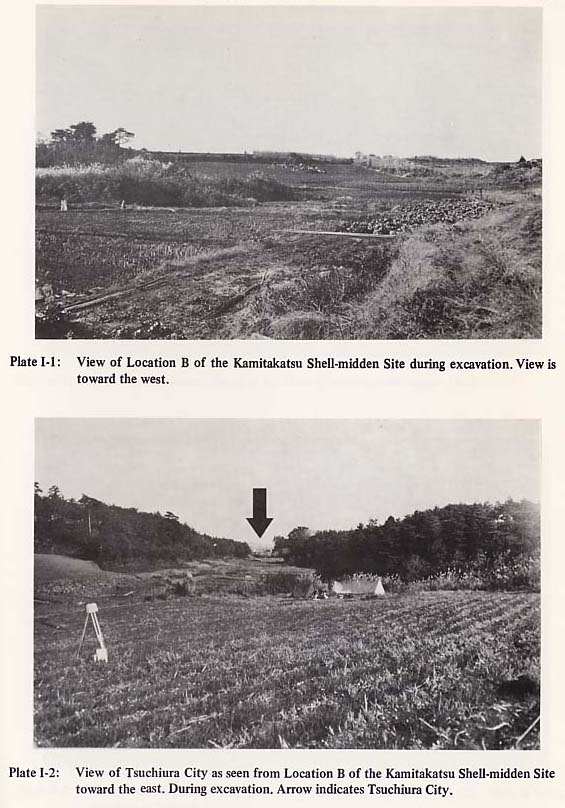
Kamitakatsu Shell-midden Site is a general name given to five areas of scattered molluscan shells which are observed on the flat plateau of the twenty to twenty-two meter terrace and on the slope around the plateau (Fig. 4). In other words, Kamitakatsu Site in its strict sense is these five locations of scattered shells. Not only shells but also potsherds and bone fragments are scattered in these areas. These five locations are different shapes and sizes in ground plan, but they are all located on the edge around the plateau.
The first record of the Kamitakatsu Site was made quite long ago; there is a paper dated in 1900 on the remains obtained from this site (Numata, 1900). However, it is not an excavation report but rather a short description of the surface materials.
The first excavation was carried out in the 1930's by the Ohyama Prehistoric Institute, but all its records were burned during the Second World War.
Then this site was not heard of until in 1950 the Archaeological Institute of Keio University started a series of systematic investigations there. The present examination paid special attention on the chronological study of the Jomon pottery types in the Kanto region, and, at the same time, by using various pottery types as the time scale, it also aimed at analyzing the sequential changes of the subsistence activities of the Jomon people viz-a-viz environmental factors. Investigations were carried out in 1950, 1968 and 1969. The results of the 1950 investigation have already been reported (Hirano et al, 1954), and preliminary reports have been published on the following two seasons (Keio Archaeological Society, 1970, Komiya, 1970).
2. Reason for the Site Selection and Excavation Plan
The purpose of the present investigation was to examine the relation between the Kamitakatsu shell-midden people and the contemporary environment. For this purpose it was necessary to study the artifacts and the numerous faunal and floral remains which could only be obtained through excavation of the shell-midden.
The site consists of five locations of shell-midden deposits. Among them Locality A has been systematically investigated by the Keio Archaeological Institute since 1950, and for this reason it was omitted from the present investigation. Among the remaining localities, Locality B was selected for the present study after a preliminary survey carried out in the following way:
First, the earth surface was observed as to whether the original features had been disturbed by road and/or field construction. Along with this a boring survey was made to examine the depth and condition of the deposits. As a result, it was found that in Location C, D, and E numerous large potsherds were scattered on the surface and that the deposits were relatively thin and soft. On the other hand, in Location B the deposits seemed relatively undisturbed and thick, so it was chosen for the present investigation.
The investigation in 1969 was carried out as a preliminary excavation in order to recover fundamental information essential to succeeding investigations. The purpose was first to determine the stratigraphy, clarify the assemblage of remains according to the each stratum, and establish the cultural stratigraphy based on these data. It also aimed at determining the distribution of the shell-midden deposits of location B.
For this purpose a two by eight meter trench was excavated in Site Grid D4 (Fig. 4, Plate II: 1). Furthermore, this trench was divided into four smaller units (each two by two meters), and each unit was used as the smallest unit for study of the vertical and horizontal distribution of deposits and remains. The size (two by two meters) of the single units coincides with that of the Keio Archaeological Institute.
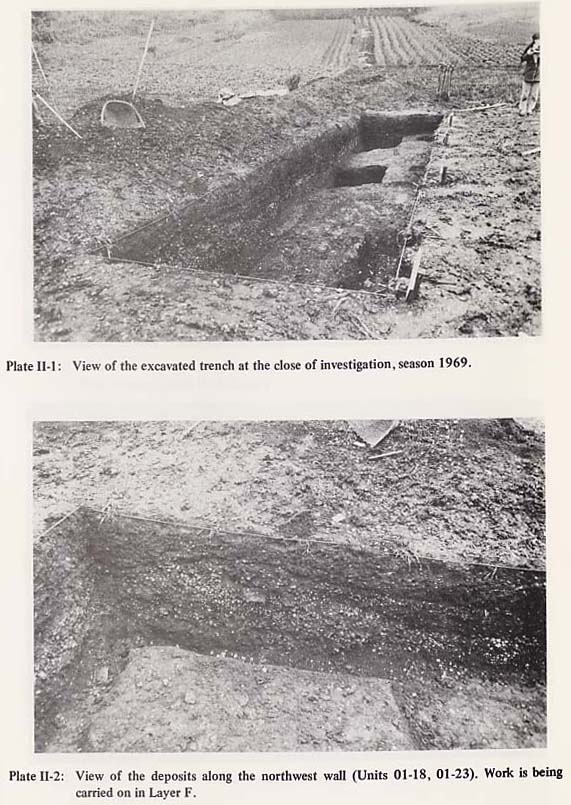
3. General Stratigraphy of the Excavated Area
After the excavation the sequence of deposits was divided into nine geological layers according to sedimentary facies and soil colors. Of these, only Layers A-E were dug completely throughout the excavated area. Three other Layers (G-I) were exposed only in pits (one by one meter) dug along the northwestern wall of Units 06-03 and 06-08 (Plate II:1). Layer F was excavated only in parts of Units 01-18, 01-23. The following is a description of the general features of these eight layers (Fig. 5, Plates II, III, IV).

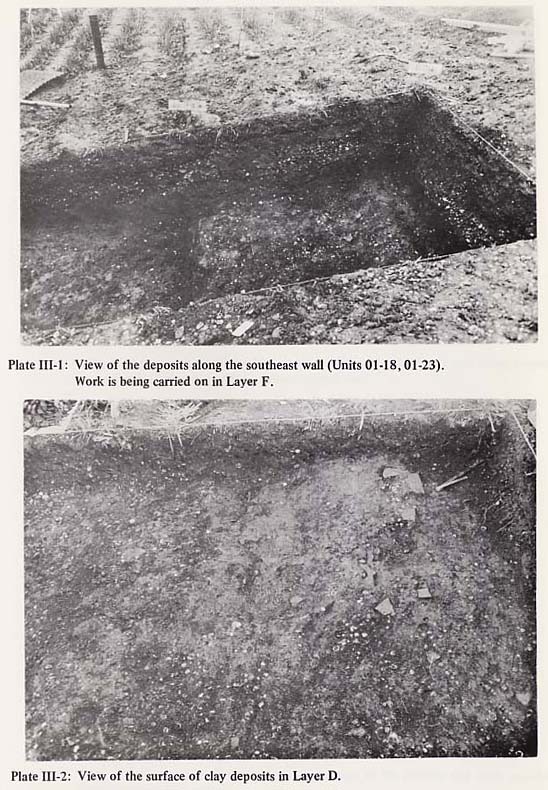
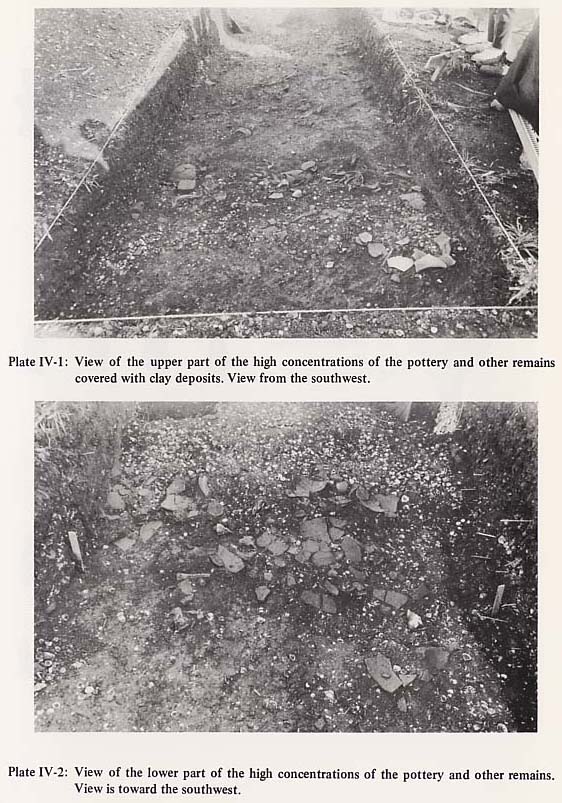
- Layer A: 10-25 cm thick.
- Very loose and porous, blackish-brown humus. This layer is cultivated every year which causes the soil to be loose and porous. Most of the molluscan shells are broken. The unbroken ones have gone through changes in color and quallty, and are readlly broken. Most of the molluscan shells are corbicula japonica (Prime). Some potsherds are also found in this layer.
- Layer B: 5-30 cm thick.
- Dark brown silt. Porous. Clearly distinguished from Layer A in that the deposits are more compact. The concentration of shells is high. Most of them are corbicula japonica, but some are Meretrix lusoria (Röding). Potsherds and faunal remains such as deer and wild pig bone fragments are present. A very few bone and stone artifacts are also present. In general the number of the remains is greater than in Layer A, and the fragments are larger than those in Layer A.
- Layer C: "Upper" -10-35 cm thick.
- Blackish-brown, silty loam, slightly porous. The concentration of shells is high. Most of them are corbicula japonica but Meretrix lusoria, Rapana thomasiana (Cross) and a few other species are included. The concentration is much higher than in Layers A and B. Most of the other remains are bone fragments, potsherds and a few bone and stone artifacts.
- "Lower" -10-20 cm thick.
- Brownish, silty loam, slightly porous. No remarkable difference is observed between the "Upper" and "Lower" divisions except that the soil color of the lower is more brownish. This color difference is so gradual that it is hard to draw a sharp boundary between the "Upper" and "Lower" divisions. The difference is not observed throughout the entire area of excavation but only in the northwestern half of the trench.
- Layer D:5-30 cm thick.
- Dark brown, silty loam. Its distribution covers the entire area of Unit 01-18 and the southwestern part of Unit 01-23. It is a homogeneous deposit without molluscan shells. Most of the remains are potsherds and bone fragments. There are also a few stone and bone artifacts. The base of Layer D is a deposit of very pure clay (approx. ten cm deep: eighty by one-hundred eighty cm wide) (Plate III:2). This layer includes no other constituents. Under the deposit of clay (and counted as part of Layer D) appear high concentrations of potsherds, bone fragments and shells (Figs. 30, 31, Plate IV). In regard to this particular layer and the remains under it, a further explanation will be given in Chapter X on structural remains.

Figure 30: Plan of the upper part of the high concentrations of the pottery and other remains discovered in Layer D. Shaded areas covered with clay deposits (See Plate IV-1). |
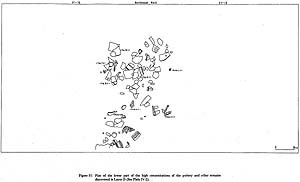
Figure 31: Plan of the lower part of the high concentrations of the pottery and other remains discovered in Layer D (See Plate IV-2). |
- Layer E: 20-40 cm thick.
- Dark brown, silty loam. Its distribution is limited to Unit 01-18 and the southwestern part of Unit 01-23. The concentration of shells is highest of all the layers discovered during the present investigation. Most of shells are Corbicula japonica, but Meretrix lusoria and Rapana thomasiana are more common than in the other layers. Animal bone fragments, fish bones, potsherds, stone and bone artifacts are also greater in number than in the other layers.
- Layer F: 10-40 cm thick.
- Dark brown to blackish-brown, silty loam. This layer was completely excavated in Units 06-03 and 06-08 but only the upper part of it was excavated in Units 01-18 and 01-23. The soil quality is homogeneous, Molluscan shells are quite scarce and completely absent toward the botton. A lot of gravel is among its constituents. The quantity of gravel is greatest in this layer. A very few bone fragments, some bone and stone artifacts and a lot of potsherds were also found.
- Layer G: 15-30 cm thick.
- Light brown, clayish sand. Homogeneous. This is observed only in the pits (one by one meter) in Units 06-03 and 06-08. Remains are very scarce. Only a little gravel and a few potsherds were collected.
- Layer H: 45-55 cm thick.
- Reddish brown clay. Homogeneous. Compact. Sterile.
- Layer I: 45-70 cm thick.
- Yellowish, light brown sand. Homogeneous. Sterile. Disturbed area.
- Along the northwestern section of Unit 06-03 there is an area (one-hundred ten by eighty cm wide; seventy-five to ninty-five cm deep) where the above sequence of deposits is completely missing. In this area a recent pit extends from the surface into Layer F and is filled with a very loose, porous, blackish-brown humus. Compared with other layers the concentration of molluscan shells is low. It is especially noteworthy that remains such as potsherds and stone and bone artifacts are extremely rare. The fact that the pit is cut vertically suggests it is the trace of an excavation trench.
|